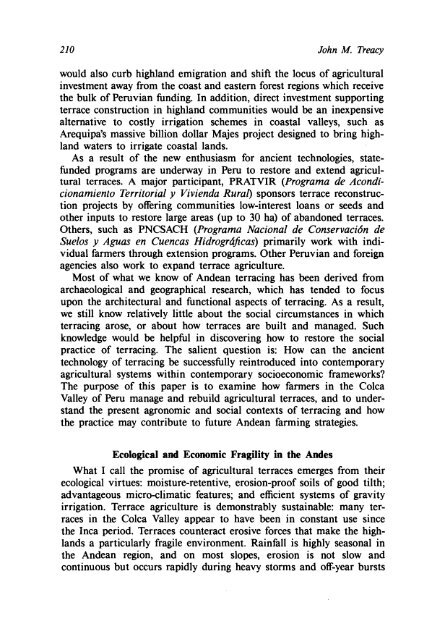Fragile Lands of Latin America Strategies for ... - PART - USAID
Fragile Lands of Latin America Strategies for ... - PART - USAID
Fragile Lands of Latin America Strategies for ... - PART - USAID
You also want an ePaper? Increase the reach of your titles
YUMPU automatically turns print PDFs into web optimized ePapers that Google loves.
21 0 John M. Treacy<br />
would also curb highland emigration and shift the locus <strong>of</strong> agricultural<br />
investment away from the coast and eastern <strong>for</strong>est regions which receive<br />
the bulk <strong>of</strong> Peruvian hnding. In addition, direct investment supporting<br />
terrace construction in highland communities would be an inexpensive<br />
alternative to costly irrigation schemes in coastal valleys, such as<br />
Arequipa's massive billion dollar Majes project designed to bring high-<br />
land waters to irrigate coastal lands.<br />
As a result <strong>of</strong> the new enthusiasm <strong>for</strong> ancient technologies, state-<br />
hnded programs are underway in Peru to restore and extend agricul-<br />
tural terraces. A major participant, PRATVIR (Programa de Acondi-<br />
cionamiento Territorial y Vivienda Rural) sponsors terrace reconstruc-<br />
tion projects by <strong>of</strong>fering communities low-interest loans or seeds and<br />
other inputs to restore large areas (up to 30 ha) <strong>of</strong> abandoned terraces.<br />
Others, such as PNCSACH (Programa Nacional de Conservacibn de<br />
Suelos y Aguas en Cuencas HidrogrdJicas) primarily work with indi-<br />
vidual farmers through extension programs. Other Peruvian and <strong>for</strong>eign<br />
agencies also work to expand terrace agriculture.<br />
Most <strong>of</strong> what we know <strong>of</strong> Andean terracing has been derived from<br />
archaeological and geographical research, which has tended to focus<br />
upon the architectural and hnctional aspects <strong>of</strong> terracing. As a result,<br />
we still know relatively little about the social circumstances in which<br />
terracing arose, or about how terraces are built and managed. Such<br />
knowledge would be helpful in discovering how to restore the social<br />
practice <strong>of</strong> terracing. The salient question is: How can the ancient<br />
technology <strong>of</strong> terracing be successfully reintroduced into contemporary<br />
agricultural systems within contemporary socioeconomic frameworks?<br />
The purpose <strong>of</strong> this paper is to examine how farmers in the Colca<br />
Valley <strong>of</strong> Peru manage and rebuild agricultural terraces, and to under-<br />
stand the present agronomic and social contexts <strong>of</strong> terracing and how<br />
the practice may contribute to hture Andean farming strategies.<br />
Ecological and Economic Fragility in the Andes<br />
What I call the promise <strong>of</strong> agricultural terraces emerges from their<br />
ecological virtues: moisture-retentive, erosion-pro<strong>of</strong> soils <strong>of</strong> good tilth;<br />
advantageous micro-climatic features; and efficient systems <strong>of</strong> gravity<br />
irrigation. Terrace agriculture is demonstrably sustainable: many ter-<br />
races in the Colca Valley appear to have been in constant use since<br />
the Inca period. Terraces counteract erosive <strong>for</strong>ces that make the high-<br />
lands a particularly fragile environment. Rainfall is highly seasonal in<br />
the Andean region, and on most slopes, erosion is not slow and<br />
continuous but occurs rapidly during heavy storms and <strong>of</strong>f-year bursts

















